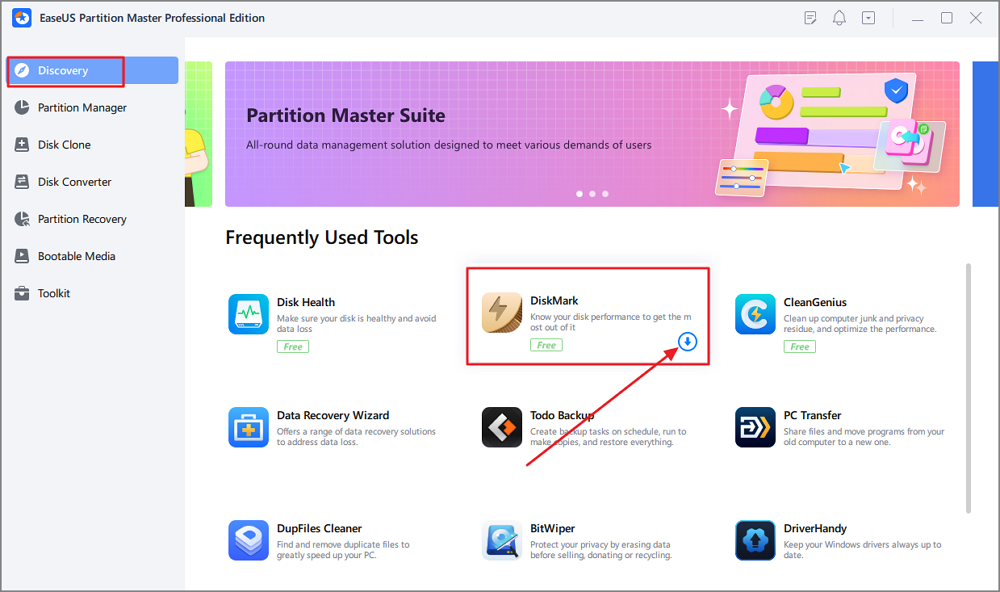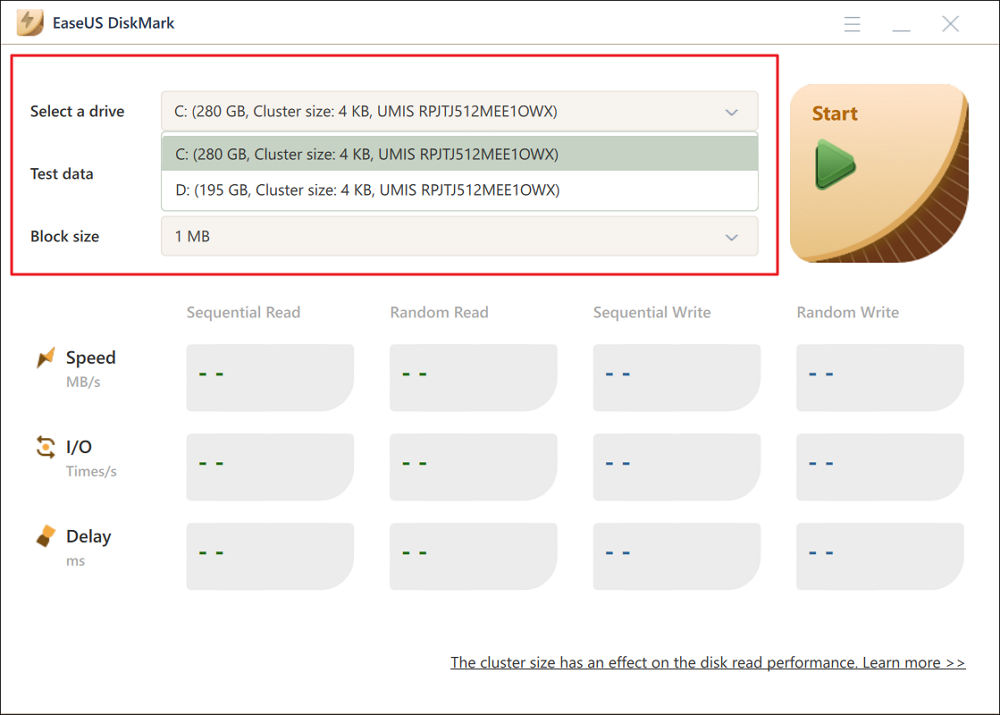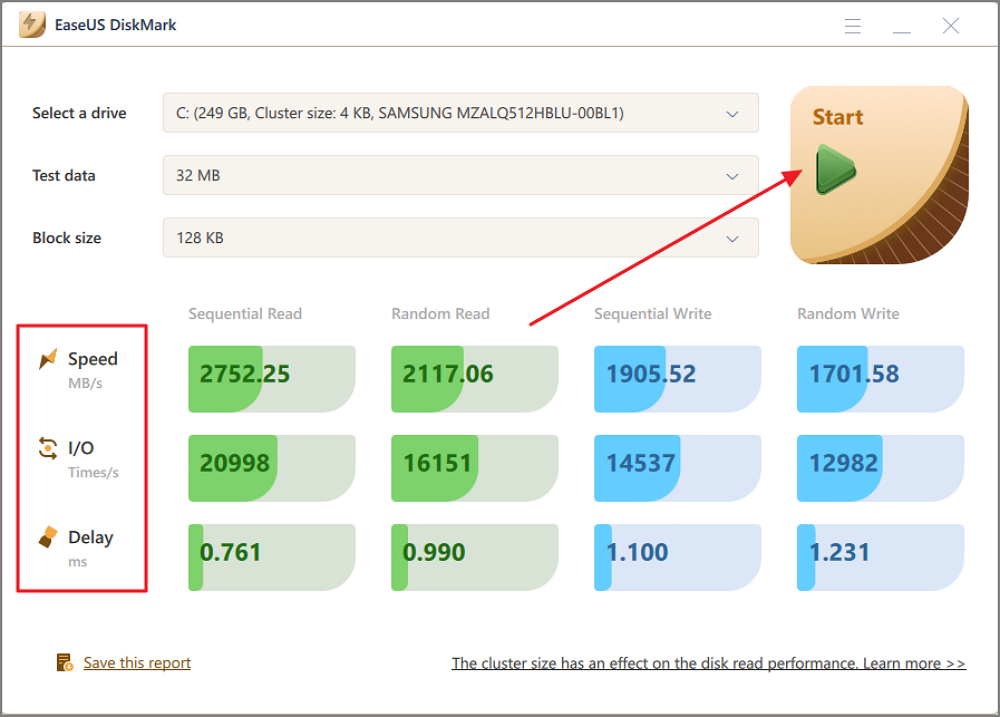Page Table of Contents
About the Author
Hot Topics
Updated on Apr 22, 2024
Key Takeaways of SSD Benchmark:
- An SSD (solid-state drive) benchmark is a test that calculates the performance of an SSD by evaluating its speed, I/O (input/output) operations per second, and other factors.
- It matters because the benchmark provides crucial information and details to determine an SSD's speed and performance in real-world applications.
This tutorial article provides helpful tips for individuals and businesses to benchmark SSD performance when they plan to purchase or upgrade to an SSD. Follow and learn how to perform SSD benchmark on your own here.

Tips for SSD Benchmark Tools Selection
If you use SSD and want to use a reliable SSD benchmarking tool to test and optimize your SSD, it's necessary to choose the best SSD benchmark tool wisely. Remember that a reliable SSD benchmarking tool should contain some basic to advanced features.
Please consider the below selection criteria for choosing a reliable SSD benchmarking tool:
| 🎉Features: | Provides detailed and accurate results for the metrics that matter to you, such as read/write speeds, IOPS, and access/latency times. |
| 👨💻Supported OS: | Compatible with Windows or macOS |
| 💵Price: | Free, or budget-friendly with a free trial. |
| ☎️Technical Support: | Available technical support options, such as user manuals, online forums, or direct support from the tool's developer |
| 🎯Bonus Features: | Provide additional features, such as SSD optimization or monitoring, to maintain the performance of your SSD. |
If you follow the listed tips in the above table, you'll be able to find and select a reliable SSD benchmark utility for testing the read and write speed and detecting its healthy status with ease. Also, it doesn't matter if you don't have the time or skill to find a qualified tool for the SSD benchmark. In the next part, you'll get one with a complete tutorial guide to fulfill the task.
SSD Benchmark Tool Recommend and Free Download
Now it's time to choose the best and most reliable SSD benchmarking tool that contains all features from basic to advance. Fortunately, in the wild, there is a tool that has all the above-discussed features, and it's EaseUS Partition Master. It provides a DiskMark feature for SSD benchmarking. This tool not only lets you do SSD speed testing but also contains several other features.
We're going to show you its key features regarding SSD testing and disk management. If we just talk about its SSD benchmarking performance, it provides detailed and accurate results for the metrics, such as read/write speeds, IOPS, and access/latency times. As well as you can also optimize your SSD.
| SSD Benchmark Feature - DiskMark | Bonus Features for SSD Performance Optimization |
|
|
| Reviewed by G2: EaseUS Partition Master is an all-in-one disk partitioning software that helps users to manage, create, delete, resize, extend, shrink, clone, convert, and migrate hard disk drives and partitions. | |
So, no more waiting, and don't spend time searching for a benchmark tool, as you already got EaseUS Partition Master. Take advantage of this tool, which offers a wide range of options from SSD speed testing to partition management. Download it now and enjoy countless features!
Or you can also share this tool online to help more friends around you to determine if their SSDs are fast or new or running an SSD benchmark test on their own:
Guide on Running SSD Benchmark for Free
As EaseUS Partition Master is a reliable SSD benchmark tool that comes with a feature of DiskMark for SSD testing, in this section, you'll learn complete instructional steps on how to use it. It's too easy and simple and provides you with 100% accurate reports quickly.
Follow the instructional steps to test your SSD quickly through the EaseUS Partition Master DiskMark feature:
Step 1. Launch EaseUS Partition Master. And click the download button to activate the "DiskMark" feature under the "Discovery" section.

Step 2. Click on the drop-down box to choose the target drive, test data, and block size.

Step 3. Once everything is configured, click "Start" to begin the disk test. Then, you can see the Sequential or Random read/write speed, I/O, and Delay data.

Compare and Check The SSD Performance After Running SSD Benchmark
Now the question is what will be the next step after running the SSD benchmark. Well, understanding the test results can help you optimize your SSD's performance and identify any potential issues.
You should take a few steps after running the SSD benchmark, such as:
- 1️⃣Saving the test report
- 2️⃣Comparing or matching your results to average SSD speeds
- 3️⃣And learning tips for improving SSD performance
#1. Compare SSD Speed Test Result with Average SSD Performance Data
Here are some average performance data for SSDs you can compare with yours:
- Read speeds: 200-550 MB/s
- Write speeds: 450-500 MB/s
And you may take a view of the SSD benchmark test result to see if the read and write speed is within the average data. If yes, your SSD is still at high performance, and you can continue using it. If not, you can follow the tips listed here to optimize the SSD performance instantly.
#2. Improve SSD Performance
Here are some tips that will help you to improve your SSD performance:
- Don't keep too much data or avoid filling your SSD.
- Keep some free space on your SSD.
- Enable TRIM as it's necessary for maintaining SSDs in tip-top condition.
- Update firmware as it offers performance enhancement and better drive reliability.
- Avoid defragging because it is not only unnecessary but bad for the drive as well.
For more details, you may follow this tutorial as a guide:

How to Improve SSD Performance in Windows 11
"How can I improve SSD performance?" This guide will show you how to prevent this and improve SSD performance on Windows 11. Read more >>
Video Tutorial on SSD Benchmark
If you need a more clear guide on benchmarking SSD and learning its real speed, here this video tutorial is to help.
Extended Reading: What Is SSD Benchmark and Why Does It Matter?
An SSD benchmark performs a test to assess the performance of a solid-state drive (SSD) in terms of speed, I/O operations, and other relevant factors. The process of running software can accurately help you estimate transfer speeds under different disk access scenarios such as sequential, random 4k, and deep queue depth. It involves executing a series of tests to calculate different metrics and produce a score that shows the overall performance of SSD.
Now, the question is, why does it matter? It matters because it tells you something which you may not know. It provides insight into how many writes it has already absorbed, how long until it fails, and the firmware number. This information lets you know whether your drive needs a firmware upgrade.
A few common metrics or factors used in SSD benchmarking include:
- Sequential Read speeds (MB/s): shows how fast SSD can read data from contiguous memory spaces; useful for accessing large files, game level loading, and some types of gameplay.
- Sequential Write speeds (MB/s): shows how fast the drive can write data to sequential memory spaces; useful for backing up documents.
- Random Read speeds (IOPS): shows how fast the drive can read data from non-contiguous memory spaces; useful for browsing the web, loading applications, and starting up a computer.
- Random Write speeds (IOPS): shows how fast the drive can complete tasks like web browsing, file compression, and loading applications; also measures the drive's ability to write data to non-contiguous memory spaces.
- Input/output operations per second (IOPS): measures the number of read/write operations that the drive can perform in a second; higher IOPS indicates better performance for tasks that require many small, random reads and writes.
- Access time: measures how long it takes for the drive to respond to a read/write request; lower access time is important for applications that require low latency.
- Latency: measures the amount of time it takes for the drive to begin a read/write operation after receiving a request; low latency improves the system's responsiveness.
Read Also:
Conclusion
SSD benchmarking is an essential tool for individuals and businesses looking to purchase or upgrade an SSD. It provides crucial information and details to determine an SSD's speed and performance in real-world applications. Choosing a reliable SSD benchmarking tool with essential features is necessary for accurate results. EaseUS Partition Master offers a DiskMark feature for SSD benchmarking that provides detailed and accurate results for the metrics that matter, such as read/write speeds, IOPS, and access/latency times.
It also contains bonus features to improve and optimize SSD performance. Running an SSD benchmark test can help you optimize your SSD's performance and identify any potential issues which can be addressed through the tool's features.
Try EaseUS Partition Master and take advantage of its many SSD speed testing and partition management features.
FAQs About SSD Benchmark
If you have more questions about the SSD benchmark, read the below FAQs, which may cover your queries.
1. How do I perform SSD benchmark on Mac?
You won't find any built-in feature or option in the Mac that can be used to check SSD speed on Mac. You need a reliable third party such as Blackmagic disk speed. It's disappointing that if you're a Mac user, you won't find a native feature to examine the hardware specifications of your device. Apple has always been known for its secrecy regarding the components beneath the sleek aluminum exterior, and this lack of transparency also extends to its software. So, if you want to perform SSD benchmark on your Mac, you have to take the support of third-party benchmarking tools/software.
2.What is the best SSD benchmark tool?
Among the jungle of SSD benchmarking tools, the EaseUS Partition Master comes with a DiskMark feature, which is the best ever for SSD benchmarking. EaseUS Partition Master provides accurate results and offers countless features, from SSD benchmarking to complete disk/partition management.
3. Can I run SSD benchmark online?
As the benchmarking process requires direct access to your computer's hardware so, running an SSD benchmark online is challenging, you need to download and install a benchmarking tool on your computer that's compatible with your operating system and hardware. For a detailed guide, follow this link: Run SSD Speed Test Online.
How Can We Help You
About the Author
Oliver is an EaseUS professional writer who dares explore new areas. With a passion for solving tech issues with straightforward guides for common users, Oliver keeps honing his writing craft by developing in-depth solutions for disk and partition management, computer boot-up issues, file transfer, etc.
Written by Tracy King
Tracy became a member of the EaseUS content team in 2013. Being a technical writer for over 10 years, she is enthusiastic about sharing tips to assist readers in resolving complex issues in disk management, file transfer, PC & Mac performance optimization, etc., like an expert.
Product Reviews
-
I love that the changes you make with EaseUS Partition Master Free aren't immediately applied to the disks. It makes it way easier to play out what will happen after you've made all the changes. I also think the overall look and feel of EaseUS Partition Master Free makes whatever you're doing with your computer's partitions easy.
Read More -
Partition Master Free can Resize, Move, Merge, Migrate, and Copy disks or partitions; convert to local, change label, defragment, check and explore partition; and much more. A premium upgrade adds free tech support and the ability to resize dynamic volumes.
Read More -
It won't hot image your drives or align them, but since it's coupled with a partition manager, it allows you do perform many tasks at once, instead of just cloning drives. You can move partitions around, resize them, defragment, and more, along with the other tools you'd expect from a cloning tool.
Read More
Related Articles
-
How to Run HDD Read/Write Speed Test in 2024 | Tried & Efficient
![author icon]() Tracy King/2024/04/22
Tracy King/2024/04/22 -
8 Fixes: Can't Install Windows on GPT or Windows Cannot Be Installed to This Disk Error
![author icon]() Daisy/2024/04/22
Daisy/2024/04/22 -
How to Boot Acer Laptop From USB on Windows 10/11
![author icon]() Sherly/2024/04/25
Sherly/2024/04/25 -
Windows 11 System Migration Software: Free/Paid Software to Move OS to SSD
![author icon]() Tracy King/2024/04/22
Tracy King/2024/04/22
Hot Topics in 2024
EaseUS Partition Master

Manage partitions and optimize disks efficiently








